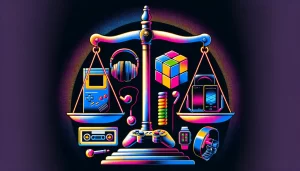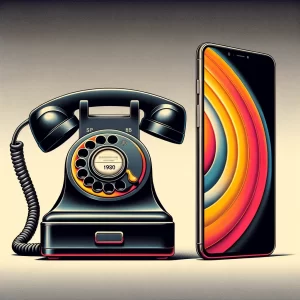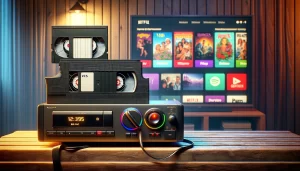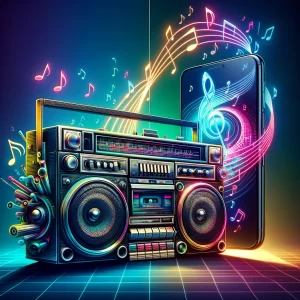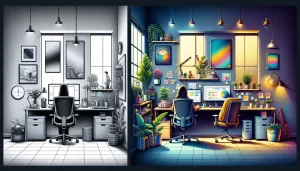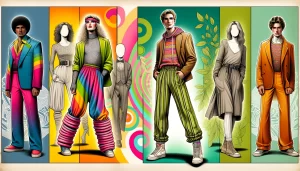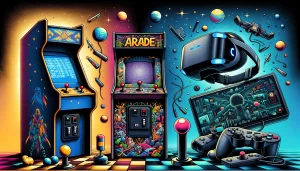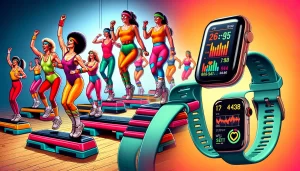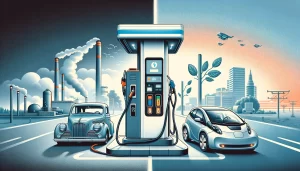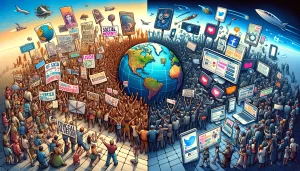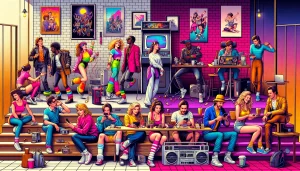The world has undergone significant transformations since the 1980s, a decade known for its distinctive fashion, booming music scene, and the dawn of the digital revolution. Today, we live in an era where technology and globalization have reshaped every aspect of our lives, from how we communicate to how we work and entertain ourselves. Let’s take a journey into ten eye-opening comparisons between life in the 1980s and today, highlighting the remarkable changes and the impact they have on our daily lives.
1. Communication: From Landlines to Smartphones
In the 1980s, landline telephones were the primary mode of communication, and answering machines were considered a luxury. Fast forward to today, and smartphones have become ubiquitous, offering not just voice calls but video calls, instant messaging, and access to the vast expanse of the internet. The shift from waiting days for a letter to instant communication has revolutionized personal and professional interactions, making the world more connected than ever before.
2. Entertainment: Video Cassettes to Streaming Services
Entertainment in the 1980s revolved around video cassette recorders (VCRs), with families gathering to watch movies or recorded TV shows. Today, streaming services like Netflix, Amazon Prime, and Disney+ have replaced physical media, offering a plethora of content at the click of a button. This shift has not only changed how we access media but has also influenced the production and distribution of content, leading to the rise of binge-watching culture and original web series.
3. Music: Boomboxes to Digital Music
The 1980s were iconic for boomboxes, mixtapes, and the Walkman, symbolizing personal and portable music consumption. In contrast, today’s music landscape is dominated by digital platforms like Spotify, Apple Music, and YouTube, allowing instant access to millions of songs and personalized playlists. This digital revolution has transformed the music industry, from how music is produced and distributed to how artists connect with their audience.
4. Work Environment: Office Bound to Remote Work
The traditional 9-to-5 office job was the standard in the 1980s, with most work confined to physical office spaces. The advent of the internet and digital technologies has since enabled a significant shift towards remote work and flexible schedules. This transformation has been accelerated by the COVID-19 pandemic, leading to a reevaluation of work-life balance and the necessity of physical presence in the workplace.
5. Fashion: Neon and Legwarmers to Sustainable Fashion
Fashion in the 1980s was characterized by bold colors, neon, legwarmers, and shoulder pads, reflecting the era’s exuberant spirit. Today, while diverse fashion trends continue to emerge, there’s a growing emphasis on sustainable and ethical fashion. Consumers are increasingly aware of the environmental impact of their clothing choices, leading to a rise in eco-friendly materials, ethical manufacturing processes, and a culture of recycling and upcycling.
6. Gaming: Arcades to Virtual Reality
Arcade games were all the rage in the 1980s, providing a social gaming experience that was as much about the atmosphere as the games themselves. In contrast, the gaming industry today has evolved with technology. From sophisticated console and PC games to immersive virtual reality experiences, the landscape offers far more today. This evolution has not only changed how games are played but has also expanded the demographic of gamers, making gaming a mainstream form of entertainment across all age groups.
7. Education: Textbooks to E-Learning
Education in the 1980s relied heavily on textbooks, chalkboards, and physical classrooms. The digital age has introduced e-learning platforms, online courses, and digital textbooks. Such advances make education more accessible and flexible. Essentially, this shift has democratized learning, allowing people from all over the world to access quality education, learn new skills, and even attend virtual classrooms.
8. Health and Fitness: Aerobics to Wearable Tech
The 1980s saw the rise of aerobics, with high-energy workout tapes and classes. Today, health and fitness have taken a technological turn with the advent of wearable tech like fitness trackers and smartwatches. These devices monitor health metrics, encourage physical activity, and even offer personalized workout and nutrition plans. Ultimately, they reflect a more data-driven approach to health and wellness.
9. Transportation: Gas Guzzlers to Electric Vehicles
Automobiles in the 1980s were often large, heavy, and not particularly fuel-efficient. The automotive industry today increasingly focuses on sustainability, with electric vehicles (EVs) and hybrids becoming more common. This shift towards electric transportation is driven by environmental concerns, advancements in battery technology, and governmental incentives, marking a significant step towards reducing carbon emissions.
10. Social Movements: Grassroots to Global Hashtags
In the 1980s, social movements relied on grassroots organizing, rallies, and printed pamphlets to spread their message. The digital era has transformed activism, with social media platforms enabling global hashtags and viral campaigns. This has amplified the reach of social movements, allowing them to mobilize international support quickly and effectively, and bringing attention to issues at an unprecedented scale.
Dramatic Changes from the 1980s to Today
The comparison between life in the 1980s and today reveals profound changes driven by technological advancements, societal shifts, and a growing consciousness about global issues. These transformations have reshaped every aspect of our lives. From how we communicate and work to how we entertain ourselves and engage with the world around us, so much is different. In the end, as we continue to navigate this ever-evolving landscape, it’s clear that the pace of change is only accelerating, promising even more significant transformations in the years to come.
Catherine is a tech-savvy writer who has focused on the personal finance space for more than eight years. She has a Bachelor’s in Information Technology and enjoys showcasing how tech can simplify everyday personal finance tasks like budgeting, spending tracking, and planning for the future. Additionally, she’s explored the ins and outs of the world of side hustles and loves to share what she’s learned along the way. When she’s not working, you can find her relaxing at home in the Pacific Northwest with her two cats or enjoying a cup of coffee at her neighborhood cafe.

